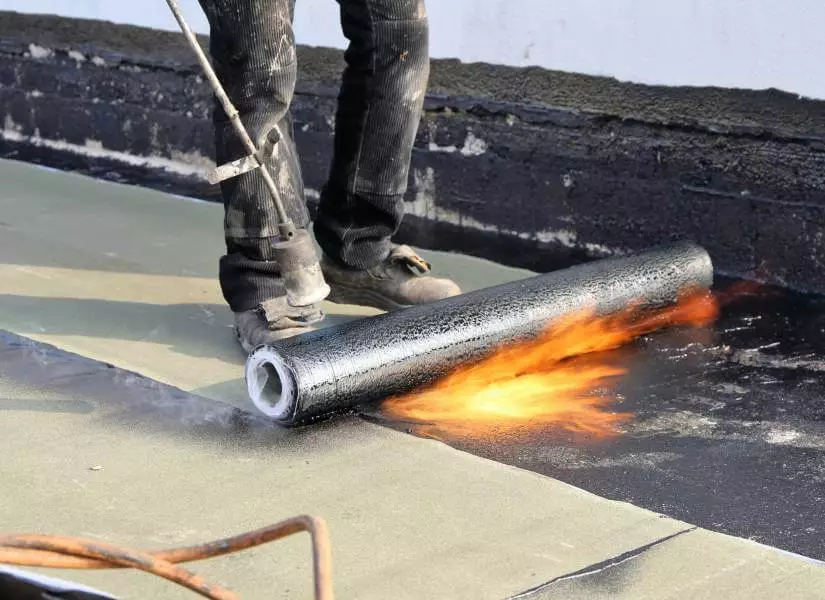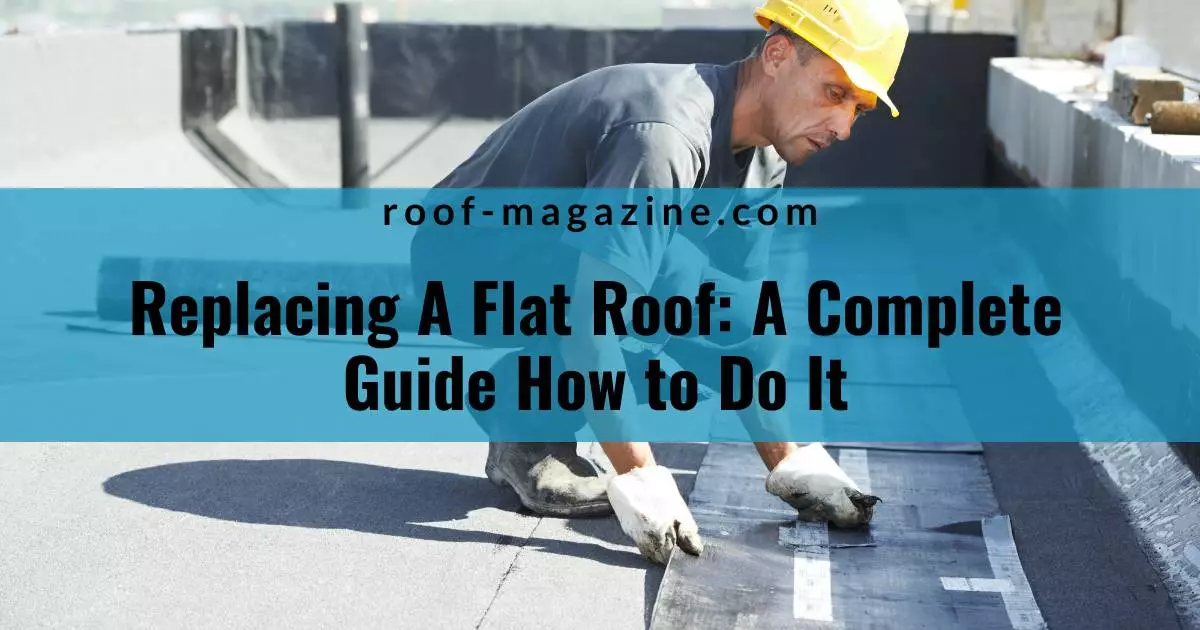Flat roofs survive an average of 10 to 15 years. A flat roof may be nearing its final phase of its useful life if you are experiencing leaks throughout that period.
Here are some telltale indicators that suggest a roof leak if you have never had one:
- Stains and water damage to your walls and ceiling
- dripping paint
- Water dripping, but not from the faucet.
- mildew on the external walls or ceiling
We will cover all you require to learn regarding replacing a flat roof in this article.
Flat Roof Materials Used in Replacement (Costs Included)
Going over the different flat roof materials that are available for replacing a flat roof and their advantages is an excellent place to start. It’s important to choose affordable roofing materials that offer durability and cost-effectiveness, ensuring long-term value and resistance to environmental elements.
1. GRP
Glass Reinforced Plastic, or GRP for short, is another name for fiberglass roofing. When decking is coated with a catalyzed resin and an additional layer of fiberglass material is placed on top, GRP flat roofing is created.
To achieve a long-lasting, weatherproof, and aesthetically beautiful finish, a fire-resistant top coat resin is placed over the first layer of catalyzed resin, finalizing the system.
GRP roofs have an amazing average 25-year lifespan and a persistent resistance to weathering. It costs $4 to $6 per ft2. GRP requires minimal upkeep throughout the course of its life, only simple repairs and occasional cleaning.
GRP is renowned for its flexibility, which allows it to be quickly and simply installed on any type of roof.
2. EPDM Rubber
The EPDM is incredibly resilient. EPDM rubber is viscous and elastic due to its elastomeric qualities. This enables the material to revert to its initial form as a result of weather-related expansion and contraction.
With only a small amount of production required and 100% recycled rubber materials used, EPDM delivers good environmental benefits. EPDM rubber has excellent insulating qualities when installed correctly.
It retains heat during the chilly winter months and reflects heat during the hot summer months. Consequently, this results in decreased energy expenses and increased building efficiency. It has an average cost of $5 to $13 per Ft2.
EPDM roofing is resilient, long-lasting, and weatherproof against UV and infrared radiation. Your flat roof should endure for up to 40 years with very little upkeep and repairs needed. It has a high level of fire resistance and can even aid in containing a fire by slowing its spread.
3. Self-Adhesive Felt
Self-adhesive roofing felt is ideal for do-it-yourselfers because it is simple to apply and doesn’t require open flames. Homeowners who choose not to hire an installer can accomplish the installation process more quickly, safely, and easily.
It’s as easy as peeling off the adhesive film to allow the felt to quickly and firmly adhere to the roofing framework. For smaller-scale projects like porch canopies, garages, sheds, and outbuildings, it is the perfect roofing material.
Self-adhesive felt, when fitted and maintained properly, can last up to 15 years due to its exceptional resilience and resistance to weather. It prevents dampness and water damage by adding a strong protective barrier against rainy weather and obstructing extra moisture.
However, it’s crucial to caution against diy flat roof replacement for larger, more complex projects. The process involves significant risks, including the potential for improper sealing that can lead to severe water damage. Ensuring the durability and effectiveness of a flat roof often requires the expertise of a licensed professional roofer who can guarantee proper installation and sealing.
4. Built-Up Tar
BUR roofing, sometimes referred to as gravel-and-tar roofing, is an asphalt and felt roofing type.
A built-up roof (BUR) creates a waterproof layer on top of the covering with tar and gravel. Maintaining and repairing this type of flat roof is easy. Apartments and condos are examples of residential and commercial buildings that frequently use built-up roofing.
While still quite common, its cost may be slightly higher than that of other materials for flat roofs. The average cost of this material is between $4 and $10 per Ft2. It has a life span of 15 to 30 years.
5. Modified Bitumen Roofing Materials
Modified bitumen, an asphalt-based roofing material intended for low-sloped roofs—has been utilized in the US. Because of its great tensile strength which means it won’t break readily under tension it can resist significant environmental pressure.
The five layers of a modified bitumen roof are adhesive, surface, modified bitumen membranes, modified foundation sheets, and insulation. Installing these roofs typically costs between $4 and $8 per square foot. If a current roof requires removal, the cost will increase.
6. Metal Roof Panels
Because metal roofs are strong, elegant, and adaptable, many people adore them. They are resilient to harsh weather, including hail and strong winds.
The typical cost of replacing a flat roof can range from $4 to $30 per Ft2. The measurement of your roof, where you live, and the kind of metal roofing you select all affect how much it will cost.
7. TPO Roofing
“Thermoplastic polyolefin” is the acronym for TPO flat roofing. The roofing material TPO is a single layer and is produced in sheets that are 10, 12, or 20 feet wide. TPO naturally reflects solar UV radiation. Learn about TPO and how its energy efficiency, durability, and cost-effectiveness make it a popular choice for commercial and residential roofing systems.
It is a common choice for business structures due to its long lifespan and impermeable nature. It requires little upkeep and is lightweight and simple to install. TPO roofing typically costs $3–$14 per Ft2, including labor and materials.
8. Spray-Applied Coatings
Coatings that are sprayed on flat roofs aid in sealing them off from water damage. There are no seams to worry about because the coating is sprayed on. It will cover EPDM roof seams for a longer lifespan.
Spray-applied coatings extend the life of your flat roof, so even if they require some laborious application, the effort and expense are well worth it. The price ranges from $3 to $10 per Ft2, depending on the substance you select
(silicon or polyurethane foam).
Replacing a Flat Roof: Step-by-Step Guide

You should expect a drawn-out process once you determine the need to replace your flat roof and select a reputable roofing contractor to handle the work. What’s involved in replacing a flat roof might be on your mind.
We’ll walk you through the flat roof replacement procedure step-by-step below so you know what to anticipate.
Step 1: Assess the existing roof before beginning the cleaning process. As needed, clean the current roof system, making sure to get rid of any decayed wood regions, boots, vents, and flashings.
Step 2: Across the entire roof area, eliminate and substitute any deteriorated roof sheathing. This step includes roof removal, specifically the removal of deteriorated sheathing, and the repair of any deteriorated areas as part of the overall roof replacement process.
Step 2.5: Given the complexities and safety hazards associated with flat roof installation, it’s crucial to engage professional help to ensure durability and proper sealing. A professional installation addresses the specialized materials and process involved, significantly reducing potential costs and enhancing the roof’s longevity.
Step 3: Take out and replace any fascia that has rotted.
Step 4: Use a licensed HVAC contractor to disconnect any existing air conditioning units.
Step 5: To comply with code requirements, manufacture and install new aluminum air conditioning stands and secure them to the deck.
Step 6: Use a licensed AC contractor to reconnect the current air conditioning systems.
Step 7: If necessary, install new AC fast disconnects.
Step 8: Cover the whole roof surface with EPS fanfold insulation and secure.
Step 9: Install, if suitable, tie-in roofing components to match the current roof.
Step 10: Develop a unique design for a PVC/CPA single-ply roof framework that is very wind resistant, incorporating fasteners across the whole roof area, boots, curbs, vents, flashings, and vents.
Step 11: Install the roofing membrane over the whole roof area, adhering to the CD standards and utilizing the items from the producer.
Step 12: Install membrane around the whole roof, secured by CD specifications, if necessary.
Step 13: Install fresh perimeter flashings, fixed 6 inches in the center, including the fascia cap, fascia bar, and drip edge. If applicable, seal the fascia bar or cap’s top flange with the appropriate sealant.
Step 14: Cover plumbing stacks with boots and, if necessary, seal.
Step 15: Where appropriate, install a curb and seal the existing vent stacks.
Step 16: If necessary for rooftop access, install a safety walk-pad network for roof traffic staff from the roof access point to the air conditioning units.
Step 17: Add moisture control vents with wind-baffle vacuum to enhance the wind uplift of the roofing system.
Step 18: Put up a rooftop sign alerting roof traffic staff to cautions and notices.
Step 19: Tidy up and get rid of everything. To get fasteners off of the lawn, use a magnet.
Step 20: All labor, materials, and manufacturer installations are covered by our warranty. (Only for business use)
Also Read: Staying Home During Roof Replacement, Should I Do It?
How Much Time Will It Take to Replace a Flat Roof?
The average flat roof replacement cost can range from $3,000 to $20,000, significantly influenced by factors such as the roof’s size, type, and the materials used. Flat roof replacement costs per square foot vary, with some materials offering more affordability and cost-effectiveness than others. It’s important to consider these factors, along with potential government incentives for flat roof replacements, to make an informed decision about the most economical option for your property.
The duration of time required to replace the system will vary depending on the kind of flat roof that you have selected. Recall that you must allow time for both installation and removal.
Based on the size of the roof space, the table below, which was generated by myjobquote, offers average projections for replacement times.
Roof Size/TypeAverage DurationFlat roof2-3 daysExtension roof2-3 daysPorch1-2 daysDouble Garage2-3 daysDormer1-2 days
The kind of material you are working with and your level of competence with it will also affect how long it takes.
Is replacing a flat roof less expensive?
Because they cover a smaller area, flat roofs are less expensive to replace. Slanted roofs are more expensive to create because they require more materials.
How long are typical flat roof lifespans?
A flat roof’s lifespan is determined by the materials chosen and the level of maintenance given. For instance, a built-up or modified bitumen roof can endure for ten to twenty years.
What is the price to install a pitched roof on a flat roof?
Installing a pitched roof of typical size on a flat roof will probably cost more than $30,000. But estimating the expenses of this kind of project might be difficult.
How frequently should a flat roof be coated?
A flat roof should be coated every five years.
Do flat roofs have more leaks?
The caliber of the installation determines this. Pitched roofs are less likely to leak than poorly placed flat roofs, but properly installed flat roofs can be just as dependable and waterproof as sloped roofs.
